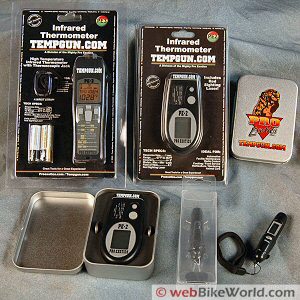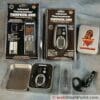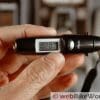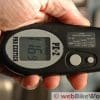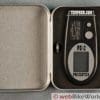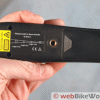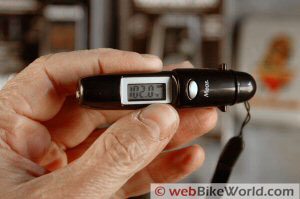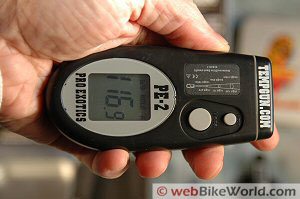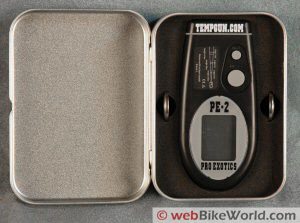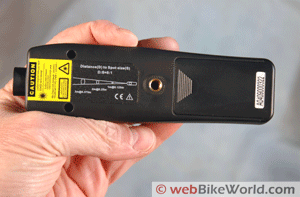Easy to use, these devices are handy for all sorts of temperature measurements.
What to do when the temperature is hovering in the teens?
The cold snap has slowed us way down (in more ways than one!), so I rummaged around in the webBikeWorld staging area to see if we missed anything.
That’s when I discovered that still we had these infrared thermometers waiting for a look-see, sent to us by the folks at Temp Gun.
If it’s too cold to ride, at least we can check to see how long it takes the bikes to warm up in these Arctic-like conditions!
Digital infrared thermometers are useful devices for all sorts of motorcycle and non-motorcycle applications.
The Temp Gun brand is sold by ProExotics, whose main business is dealing in reptiles, including exotic snakes, lizards and other interesting cold-blooded critters.
Reptiles are very sensitive to temperature changes, and their owners use infrared thermometers to maintain an optimal environment. Infrared thermometers are also popular with hobbyists for tuning gas-powered engines in model race cars and airplanes.
But we’ve found that a good infrared thermometer is also very useful with motorcycles.
We reviewed the original Temp Gun PE-1 a while ago, and the Temp Gun Mini, the PE-2 and the PE-3 laser infrared thermometers shown here complete the Temp Gun product line.
The PE-2 and PE-3 have built-in laser pointers, and although I have questioned the usefulness of the laser designator in the past, I’ve since changed my mind because of the accuracy of these two new Temp Gun units.
Owners report a zillion and one uses for infrared thermometers.
That includes everything from fooling around by measuring the temperature of, uh, interesting areas on the human body to serious research where precise non-contact temperature measurement is necessary.
Motorcycle racers use them to measure tire temperatures, cylinder head temperatures and exhaust manifold/exhaust pipe temperatures.
We use them to check the temperature of heated grips, heated jackets, bearings, brake rotors and brake drums.
And they come in really handy for keeping tabs on trailer tire, axel and bearing temperatures when you’re towing a motorcycle on a trailer.
But you can always sneak a measurement of an ice cube at your next party and then hold it next to your buddy’s head to prove that he’s got nothing going on upstairs!
Let’s take a look at this new batch of Temp Gun products, starting with the Mini and working up to the PE-3, which is an industrial-strength laser digital infrared thermometer that even has a built-in tripod mounting screw.
Temp Gun Mini Infrared Thermometer
The PE-Mini ($30.00) is the latest member of the Temp Gun family.
This is the infrared thermometry at its most basic.
But the Mini does just about everything you’d ever need a thermometer to do, and “it’s cute as a button” (according to my wife) as a bonus.
Too bad it doesn’t come in pink…
The Mini is only 82 mm long (3-1/4″) and 17 mm in diameter (~5/8″) and it weighs a miniscule 17 grams (5/8 oz.). It comes with a wrist strap and a built-in pocket clip, so you can carry this baby anywhere.
The Mini includes two LR44 1.5 Volt watch batteries, which are replaceable by removing a tiny Phillips head screw on the back cover.
The back side also has a tiny switch which can be pressed to display the temperature in either Celsius or Fahrenheit (default), although you’ll need to use a needle to access the button, hidden under a hole in the pocket clip.
It measures from -27° F to 356° F, or Celsius -33° C to 180° C, and it takes the reading in less than one second.
Aim the Mini, press the button on top and either hold it to take a continuous temperature reading or release the button, which will hold the temperature on the display for 15 seconds.
The LCD also includes a battery life indicator; the Mini’s battery life is projected at 30 hours of continuous use, which is a lot of temperature readings!
The Mini can be used in ambient temperatures ranging from 32° to 122° F (0 – 50° C), and it is claimed accurate to within ± 2.5%.
It has a “distance to spot ratio” (D:S) of 1:1, which means that when it is 1 inch away from the surface, it measures a spot that is 1 inch in diameter.
At 1 foot, it measures a spot that is 1 foot in diameter, so the Mini must be held as closely as possible to the intended surface. The Mini is guaranteed for one year.
Temp Gun PE-2 Infrared Thermometer With Laser
Many owners have requested a laser pointer for their Temp Guns, and the PE-2 has one but still maintains a relatively low price of $45.00.
Note that the laser doesn’t read the temperature, it just indicates that portion of the surface where the temperature will be read.
The PE-2 has a pear shape that fits nicely in the hand. It weighs 82 grams (2-7/8 oz.). It measures about 109 mm long (4-1/2″) and 50 mm (2″) wide at its widest point. It is 20 mm (3/4″) thick.
The PE-2 reads from -27° F to +482° F (-33° C to 250° C) with an accuracy of ± 2° (that’s 2 degrees, not 2 percent).
It can be switched back and forth by first pressing the measurement button, then by pressing the “mode” button 4 times.
The PE-2 has an adjustable emissivity setting, but I have no idea why you’d want to do this, so I’ll have to consult my scientist friends.
The way I understand it, emissivity is a measurement of a material’s ability to emit infrared energy, and it ranges from 0 to 1.
The PE-2 has a very tight distance to spot ratio (or D:S) of 8:1, which means that it will read a diameter of 1 inch when the PE-2 is 8 inches from the surface.
It also has a temperature display lock, and the ability to display error messages on the LCD when, for example, the temperature being measured by the thermometer is out of range.
The PE-2 uses two CR2032 lithium camera batteries (included). One battery runs the laser and the other battery runs the infrared thermometer, so the device will still read a temperature with only one battery in place.
A nice aluminum padded storage box with two extra batteries is available for an extra $10.00, which just about covers the cost of the spare batteries anyway, so it’s worth it.
Battery life is projected at 40 hours of continuous use and the PE-2 is also guaranteed for one year.
A wrist strap is not available for the PE-2 and it is also guaranteed for one year.
Temp Gun PE-3 Infrared Thermometer With Laser
The PE-3 infrared thermometer is the super-deluxe, all-singing-and-dancing, “top of the line” Temp Meister (my words).
It’s designed for professional use, which should be of interest to all you BMW owners ;-). It retails for $100.00.
The PE-3 measures 145 mm long (~ 5-5/8″), including the protective plastic ring around the infrared reading module. It’s 42 mm wide at the widest point (~ 5/8″) and 27 mm thick (3/4″). It weighs 125 grams, or 4-3/8 oz.
This non-contact infrared thermometer will measure from a cold -76° F to a blistering +1000° F (-60° C to 538° C).
It even includes a jack for an eternal thermocouple will read from -83° F to +2500° F (-64° C to 1371° C), so if you need to measure temperatures with a broader range than that, you better call NASA.
The PE-3 laser can be turned on and off from the “keyboard” on the face of the device.
And the LCD has a switchable backlight.
The PE-3 also has adjustable emissivity, and it adds the ability to average the temperature readings.
It can also be set to sound an alarm when it reaches a specific high or low temperature.
While it takes some study to figure out all of the PE-3’s functions, taking a temperature reading is as simple as pressing the big “Measure” button.
The PE-3 can also calculate the difference between measured high and low temperatures, which comes in very handy because you can scan the engine or tires to find temperature differences.
It has an 8:1 D:S ratio and is accurate to within ± 2°. It takes two AA batteries (supplied), which give it an amazing 360 hours of continuous use.
I don’t have the accessory thermocouple, which would be great for contact measurement of motorcycle tires at the track.
The PE-3 also a wrist strap and a soft case with a belt loop and it’s guaranteed for one year.
Conclusion
A digital infrared thermometer may seem like a frivolous expense for motorcycle use, but it’s one of those things that once you have one, you’ll figure out all sorts of uses for it.
Tool freaks, take note! You should really have one in your toolbox, especially at a track day.
The Mini is still a great way to learn what these devices are all about, because you can hang it around your neck or carry it in your pocket.
You’ll learn a lot about your environment and you’ll impress your friends at the same time!
The PE-2 and PE-3 are full-featured infrared thermometers, now with laser pointers that actually do help to isolate an exact location for measuring the temperature, especially with their 8:1 D to S ratio.
Both the PE-2 and PE-3 have calibrations traceable back to the U.S. National Institute of Standards and Technology.
More: Temp Gun PE-1 Review
| wBW Review: Temp Gun Digital Infrared Thermometers | |
|---|---|
| Manufacturer: Temp Gun | List Price: $25.00-$100.00 |
| Colors: Black | Made In: China |
| Review Date: January 2005 | |
Owner Comments and Feedback
See details on submitting comments.
From “R.C.”: “Dear Editor, Thanks for a spectacular site. I generally find myself using your site as the first stop when researching bits and pieces for the bike.
I stumbled across your review of the infrared thermometers this morning and thought I might submit a few unsolicited comments.
Perhaps this might help others get the most out of their tool. I know it’s an older review, but I’m pretty sure I’m not the only one to troll through your archives.
Let me preface this by saying: a) I don’t work for any company that manufactures IR equipment; and b) I’m an industrial thermographer (among other things).
The first comment is that these are awesome tools when used properly.
They’re so cheap and so useful these days that if you have more than a slight passing interest in vehicle or home maintenance you need to get one.
I use mine (personal version – $50) for exactly the same things you mentioned in the article. In addition, you can use these tools for:
- Insulation inspection in your home;
- Electrical components (dirty contacts & undersized wires get hot; check your electrical breakers and outlets at home – it’s frightening);
- Rotating equipment (questionable bearings on a motor/pump/shaft? Dodgy bearings get hot)
And a million other uses (Don’t lie. You know you checked for “hot spots” on your significant other. And if you hadn’t already, you want to now.)
I suggest that folks interested in some really cool photos and uses visit the web sites of some IR camera suppliers. FLIR is a good example.
They have a helicopter-mounted IR camera doing nighttime fly-bys of power transmission lines checking for hot transformers.
I use my company’s $60k color IR camera constantly looking for hot spots in 800 degree refractory-lined chemical piping.
Here comes the caution part. These tools in your review are fairly accurate, but shouldn’t be used (much) for absolute temperatures. For that you need a contact pyrometer.
The reason is that all IR measurement is based on a concept called ‘emissivity,’ which is a description of how much radiation an object emits, based on surface color, texture (finish), and a few other variables that don’t really matter for home users.
Think of it this way. You have two metal plates. One is highly polished, the other is sandblasted and black.
If you heat both of them up to 200 degrees the black one will cool down faster, because dark, rough objects absorb and release energy more quickly than do white or polished items of the same configuration.
Your tire and polished rim may be the same temperature, but the tire is emitting IR radiation much more efficiently.
It’s for the same reason that the inside of your thermos and ice chest are shiny and not flat black. And why you should never polish a radiator.
This relates to scanning something with an IR camera (or thermometer, as in your review) because the low-cost tools are pre-set to an average emissivity level.
At the range and distance where these things are expected to be used, most folks won’t care if it’s 5 or 10 degrees off from absolute.
On my painfully expensive camera, I have the ability to adjust the emissivity setting to compensate for different materials, allowing me to obtain reasonably accurate temperatures across a wide range of conditions.
This is simply not possible with a $60 tool.
Now comes the advice part. Use these tools as a comparison device. Don’t compare the polished cylinder head temps to the black tire surfaces on your vehicle.
Instead, take a reading on a cold tire, and then compare it to the hot reading on the same tire.
Then take another reading on the same tire under different conditions (i.e. after riding Deal’s Gap in anger).
Ditto for the cylinder head or other parts. This will give the user a pretty good idea of temperature change on the same material.
And, as you mentioned in the review, they are much better at detecting exhaust pipe temperature differences than the old “fling a wad of spit at the pipe and see how long it takes to sizzle off” method of carb/ignition adjustment.
If you really want to be an*l — like I have to be when lives are possibly on the line — get a contact pyrometer and compare readings between the IR tool and the pyrometer for a variety of materials.
Pyrometers are cheap; most decent multimeters come with one.
Just don’t use the thing and think “Yep, the tire is exactly 98F.” Instead, you should think “Yep, it’s a LOT hotter than when my buddy borrowed it.”
Or worse: “The tires are hotter than when she rode it on the same bike/track/lap times. I need to stop horking Ben & Jerry’s like it’s free beer at a NASCAR race.”
Sorry for the long-winded comment. I just find it cool when my hobbies and profession touch each other. And, frankly, I’m a dork. Hope it helps.”


